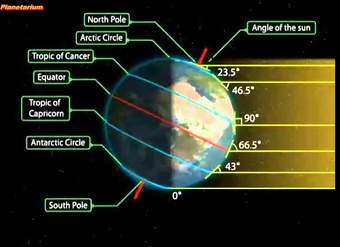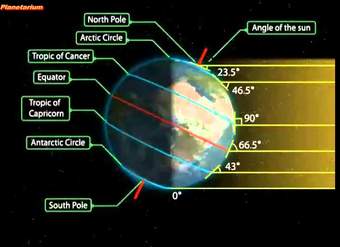Mechanism of The Seasons
Mechanism of The Seasons The seasons result from the Earth's axis being tilted to its orbital plane; it deviates by an angle of approximately 23.5 degrees. Thus, at any given time during summer or winter, one part of the planet is more directly exposed to the rays of the Sun. This exposure alternates as the Earth revolves in its orbit. Therefore, at any given time, regardless of season, the northern and southern hemispheres experience opposite seasons. The effect of axis tilt is observable from the change in day length, and altitude of the Sun at noon (the culmination of the Sun), during a year. Seasonal weather differences between hemispheres are further caused by the elliptical orbit of Earth. Earth reaches perihelion (the point in its orbit closest to the Sun) in January, and it reaches aphelion (farthest point from the Sun) in July. Even though the effect this has on Earth's seasons is minor, it does noticeably soften the northern hemisphere's winters and summers. In the southern hemisphere, the opposite effect is observed. Seasons result from the yearly revolution of the Earth around the Sun and the tilt of the Earth's axis relative to the plane of revolution. In temperate and polar regions, the seasons are marked by changes in the intensity of sunlight that reaches the Earth's surface, variations of which may cause animals to go into hibernation or to migrate, and plants to be dormant. During May, June and July, the northern hemisphere is exposed to more direct sunlight because the hemisphere faces the sun. The same is true of the southern hemisphere in November, December and January. It is the tilt of the Earth that causes the Sun to be higher in the sky during the summer months which increases the solar flux. However, due to seasonal lag, June, July and August are the hottest months in the northern hemisphere and December, January and February are the hottest months in the southern hemisphere.
Crear modelos que expliquen los fenómenos astronómicos del sistema solar relacionados con:
- Los movimientos del sistema Tierra-Luna y los fenómenos de luz y sombra, como las fases lunares y los eclipses.
- Los movimientos de la Tierra respecto del Sol y sus consecuencias, como las estaciones climáticas.
- La comparación de los distintos planetas con la Tierra en cuanto a su distancia al Sol, su tamaño, su período orbital, su atmósfera y otros.
Tipo: Imágenes y multimedia / Videos
Curso: 1° Medio
Asignatura: Ciencias Naturales
Fuente o Colección: Youtube: CURRICULUM MINEDUC
Modalidad: Educación General



